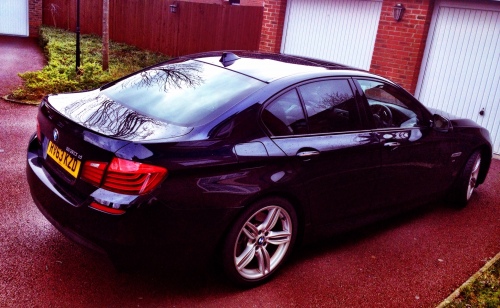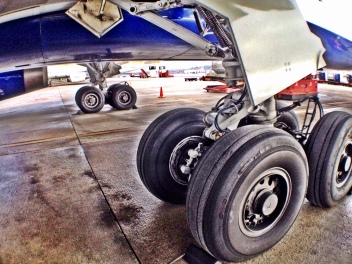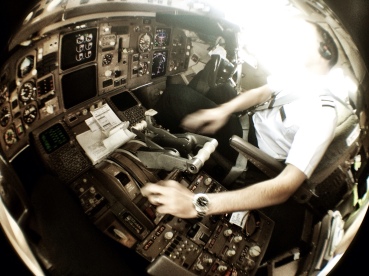This is a picture of the Service Manager's car. It must be very inconvenient for him to give up his car for the next four days? You might be wondering why I have shown you a picture of a 5 series? What could this possibly have to do with airlines, aircraft and all the usual stuff that I tweet about?
I am fairly certain that the 5 series is the best saloon car on the planet. This one is very nice. Just the right amount of toys, nice colour combination, 8 speed auto. The technology is fantastic. Even the iDrive is intuitive enough to allow me to use it without ending up in a ditch.
So here's a thing. I have just been on the receiving end of a lengthy error chain. My car ended up with wrong-sized tyres fitted. Completely wrong. The service centre didn't spot it, I did. And when I told them, they tried to convince me that I was mistaken. The experience has been interesting to say the least. I thought I would use it as a parable to illustrate how safety and brand are interlinked. If you want to know how having a good set of safety 'behaviours' can affect a company's bottom line, read on.
Wind the clock back three days. I am trundling to work on the A30. My BMW 1 Series is just about the nicest all-round car I have owned (and I have owned LOTS of cars, especially BMWs). It is comfortable, drives nicely, doesn't cost a fortune to run, looks equally at home with the seats down driving to the tip as it does pulling up outside a posh hotel. It is relevant to this story that BMWs are pitched as 'premium products'. In buying a BMW I, like many others, have spent more money buying a product which I perceive to be 'better' than cheaper alternatives. The Ultimate Driving Machine. Maybe. It is undoubtedly a magnificent bit of production engineering. Maybe I'm a dullard for paying the extra cash? I am no different from anyone who buys anything but the absolute cheapest of any product.
BONG. The central display turns orange and an image of a car appears. A little 'caret' points at the orange car's left rear wheel. BONG BONG. The display changes again. A bit more urgent. Pointers at all the wheels, the multifunction screen changes. Not a happy car. I pull into a service station a little way up the road. Runflat tyres: the left rear looks pretty normal to be honest. I know from having received a nail through a tyre on my Mini Cooper S after only 8 miles of ownership that it is difficult to see a flat. It takes a lot of air. Reset the system, drive the remaining 3 miles to work. When I get out of the car I can hear the air escaping.
Being a cautious kind of guy I took out tyre insurance (after my Mini Adventure!) so I call the dealership; we discuss my tyre insurance. The gentleman needed to know the tyre size which I thought was odd. I trudged back out to the car and crouched down in the pouring rain to read out the tyre size and speed rating. Apparently the tyre was 'unusual'. This seemed weird enough for me to question – “they are just the tyres that the standard car comes fitted with, that seems odd?” I began to doubt his competence just a tiny bit. I asked to him to order two tyres because I dislike having a spread of wear depths across the car. Good news, the tyres would arrive the next day. I had a diary full of meetings and appointments so clearing out a morning was a major hassle. I drove home very carefully after failing to get any more air into the tyre. Wet, slow, squirmy in places, but safe.
“…the charm thing…”
I sat in the service reception early the next morning: cafe style. A service 'representative' does the charm thing. There's free coffee, Sky News and a big board full of other BMWs that you might want to buy. I deliberately distance myself from this board. Dangerous. Last time I did a similar thing I almost ended up owning a bright orange 1M, pen quivering over the final documentation. Premium service style gets you coming back for more… if it's done well.
An hour later, car done, all paid up (insurance didn't cover it because I had gone under 3mm in one tread position) I scooted out to the car in yet more rain. I looked at the tyres briefly. They looked quite – well – big. Bulbous was the word that popped into my mind (I thought of Lord Melchit “Crevice, now that's a dirty word”). I needed to get on the road; a new team member to meet and an appointment with the CAA was ticking ever closer.
“…the car felt peculiar…”
The car felt peculiar on the way in to work. Peculiar enough for it to play on my mind. I'd never noticed it sound so 'crashy' over bumps. It seemed to sit differently on the road. Ever so slight. But cars always feel different with fresh tyres on, don't they? I was in work early the next day. Lots to do and an early getaway needed to make good an evening out. I had parked in the open. Walking towards the car in the daylight it looked all wrong. As I approached it side on it just looked funny (this non-specific recognition is really important in specialist or expert error-trapping).
For once it wasn't raining, so I stood a few feet away sipping my oh-so-middle-class-mocha staring at my oh-so-middle-management car whilst airliners roared overhead. Spot the difference: each tyre had a very different profile, no protective edge-beading. The sidewall section was totally different to the wheels on the front. I carefully read the read the lettering on the sidewalls. The tyres were even called something different – some weird eco-name thing. That was enough for me. I rang the service centre again. The call progressed like this:
Irritating menu, wait, nice receptionist, holding music, service 'representative'. Me: “Hello, look, I might be going completely mad but I think that you put the wrong sized tyre on my car”. Rep: “Riiiiiiight. Do you know what size they are?”. At this point I was starting to think about how BMW manage their customer data. They only fitted them yesterday, presumably he could just look that kind of thing up? I had probably had 10 different interactions with BMW over a 48 hour period and in most of them I had been forced to start from the beginning of the story. Me: “I was hoping you could check the tyres that you fitted against the spec for my car? These just look way too big”. Rep: “They are probably bigger at the back than the front”. OK… now this is getting silly. At this point it should have been pretty simple to check one bit of data against another bit of data. We went back and forth a bit. Lord knows what he was checking. I even Googled “118d M Sport tyre size” and got the answer I needed inside 10 seconds. But BMW might know better than Google, right? They are the experts.
90 minutes of to-ing and fro-ing confirmed what I had found in a single Google search. Wrong tyres, far too big. The process of fobbing off began: The tyres will be fine… Maybe I could come in sometime next week? Wait a moment. I had been out to the car and studied the placard on the door frame. Nowhere was this tyre size listed as acceptable for the car. There were plenty of other sizes but not this one. I queried it again. “I really need to understand if the car is drivable in this condition?”.
“Yes, it's fine”. Really? What about the wheel arches? Clearances? Speedometer accuracy? What about my insurance? Yes, it will all be fine. I stopped the guy and ran him through my tyre insurance scenario. One tread position was measured at 2mm. No tyre insurance. I suspected that an insurer would take a similar view if I was involved in an accident… sorry but your car is fitted with a peculiar tyre config. That's an undeclared modification – we won't pay.
My evening was ebbing away. In all probability I would miss out on the restaurant and maybe miss the start of the performance. As far as I could see this problem was still mine – it didn't belong to BMW. Yet. My final questions were to ask if they could provide me with a car for the weekend and what would happen to prevent a similar incident happening again. Extraordinarily, he said that they didn't have any cars (odd for a car dealership) and that they would 'look into' the incident. Unsatisfactory. A whiff of BS, too. He had spoken to the 'Master Technician' about it. My mind wandered to a chap in pristine overalls sitting cross-legged on a Snap-On toolbox.
Manager on the phone. Nice chap. I felt sorry for him really. For the first time I was talking with someone who genuinely seemed to understand that this had all gone wrong. “When I looked at that tyre size I knew instantly they were wrong for your car, sir”. We had a nice chat until he started talking about how the tyre company was actually a supplier and not part of their organisation. This winds me up. I'm a customer, I don't care how the business is structured.
So here I am. His car is parked neatly in front of my house. Very handy it is too. If you trade on a reputation for quality and excellence you have to deliver it: even when mistakes happen. A lot of organisations work on the assumption that 'better' is a 100% record of perfection. It might even be achievable in some cases. But in complex safety-related environments it is likely that error or failure will occur eventually. For me the error was spoiling my trip into the Big Smoke. For an airline customer it could be lots more serious.
Making a Responsive Safety Culture
So what is the key to making a responsive safety culture and rescuing the situation? Is it even worth it?
To answer the second question first: yes it is! Look at this situation. There's a large, difficult-to-quantify cost when you compare making the same error (ordering the wrong tyres) and intervening early with what actually happened. There is still a price for the error. The early intervention option would be mildly frustrating to the customer, it might cost the price of a cab to Heathrow, or the use of a demo car for a day. It comes with the upside that I wouldn't be wondering what else the mechanic has not checked. I wouldn't be thinking of using another dealership in future. Nor would I be wondering if the Audi dealership were any better (they are not, by the way, I can confirm). I wouldn't be writing this and you wouldn't be reading it. None of this would happen.
So, if there is a way of trapping errors more effectively the result is a happier customer, less money spent on the problem and improved customer retention.
First question second: A responsive safety culture? It may come as a surprise that the answer can be found in the quality of individuals that your organisation employs. Their aptitude, experience, preparation and engagement all has a bearing on the end result. Let's pick this event apart… almost like it was an aircraft incident.
Recognising that 'Something is Up'
Malcolm Gladwell (@gladwell) in his book 'Outliers' talks about the key to expert behaviour being the '10,000 hour rule'. Gary Klein (@KleInsight) in 'Sources of Power' tells us about 'Fire Ground Commanders' who had a 'sixth sense' or highly advanced intuition which tweaks something deep inside their skulls when it is time to get the hell out of that house. Kahnemann is his fantastic book 'Thinking Fast and Slow' disagrees with Klein postulating that “…intuition is just recognition…” but the glue that binds all three is that the human brain is extraordinarily capable of gathering information from a variety of indicators. The subconscious brain is always pulling data in. The brain is even capable of piecing together bits of other, similar scenarios to apply experiential learning to a previously unseen set of parameters.
For example, I know nothing about tyres, or 1 Series running gear geometry but I applied my knowledge of what my car normally looked like and my skills learned through years of flying air tests and acceptance flight to know that something wasn't quite right.
The service manager applied his specialist knowledge and found a probable answer in moments “…they were wrong for your car…” because he has spent years around BMWs.
So what about missed recognition opportunities? When the service guy set the order up, the tyres were 'special order'. He told me that. I even queried it. It's pretty strange for a company to not carry a consumable item in its regular inventory for a popular product. The technician who sent my car on its way must have seen how tight the tyre looked in the wheel arch. I wonder whether his internal monologue tweaked his experience? Being sensitive enough to slow down a little when something doesn't quite feel right is a skill. You have to train it into people – especially in a world full of normal. High density shorthaul operations are like this: especially in the Airbus. Everything ticks along beautifully. Another ILS, another loadsheet, another datalink clearance, another………
Permission is Easier to Grant than Forgiveness
Strange though it may sound, you usually have to give your team 'permission' to act on their intuition. How this happens is bespoke to specific organisations – it can be a difficult thing to describe. The difference or oddness that you have recognised might be something… or it might be nothing. If it's nothing, then that might delay, disrupt, annoy. All for – well – nothing. You might even be seen as 'risk averse' or 'overly cautious'. It's a balance, of course, but letting your teams know that it is OK to call a halt when something doesn't seen right is the bedrock to developing a healthy culture.
Mitigation is OK – Sometimes
This fell out of favour in some organisational cultures for a while. Sorting stuff out when things had gone wrong became the marker of failure. Riffing around the daily disaster wasn't the way to do business. What was needed was better technology, better systemisation and improved process. All of that is correct but if you ignore likely failure modes then your 'system' becomes a 1 or a 0. It either works or it doesn't and it begins to lose the ability to self-heal. That is not a recipe for resilience. You can see this characteristic in this event: “…it's OK to drive the car…” reads like 'press on', or 'it's OK, I've got it'. As an instructor and when debriefing events I see pilots persisting with automation modes that have become inappropriate as the circumstances have changed (maybe you were flying a FLCH descent but now you are really above the glidepath?). Knowing when to switch from the planned, polished product to the dirty old rescue vessel takes practise too.
Owning the Problem
The remedy has to belong to someone. If the problem occurs on my watch then I have to be the person that fixes the problem. That means that I have to admit that the problem exists. It might be embarrassing and I might even want to blame it on some external factor. None of that washes. The success of the outcome depends on someone seizing hold of the issue and steering it to a conclusion. If the moment of commitment is missed then a spiral develops. Perhaps on my first call the Rep could have said “drive the car straight here. It's our mistake. I'll have a car waiting for you and we will call you when your vehicle is fixed”? Instead we stuck with 'bring it in next week'. You take the risk on your insurance etc. We will treat you like a normal customer in the systematised conveyor.
In the airline world I hear it a lot: ATC really screwed us for mileage, or even the slightly more Freudian “the aircraft was unstable at 1000 feet” as if it had developed a consciousness. The joy of the aviation environment is that these interactions happen all the time. The dynamism is what makes any job fun and fulfilling. Solving problems and making stuff 'right' requires sensitivity and flexibility. Get it right and you will take your customers with you as well as head off more unnecessary costs. Get it wrong and you'll not even have a chance to say 'sorry' a second time.






